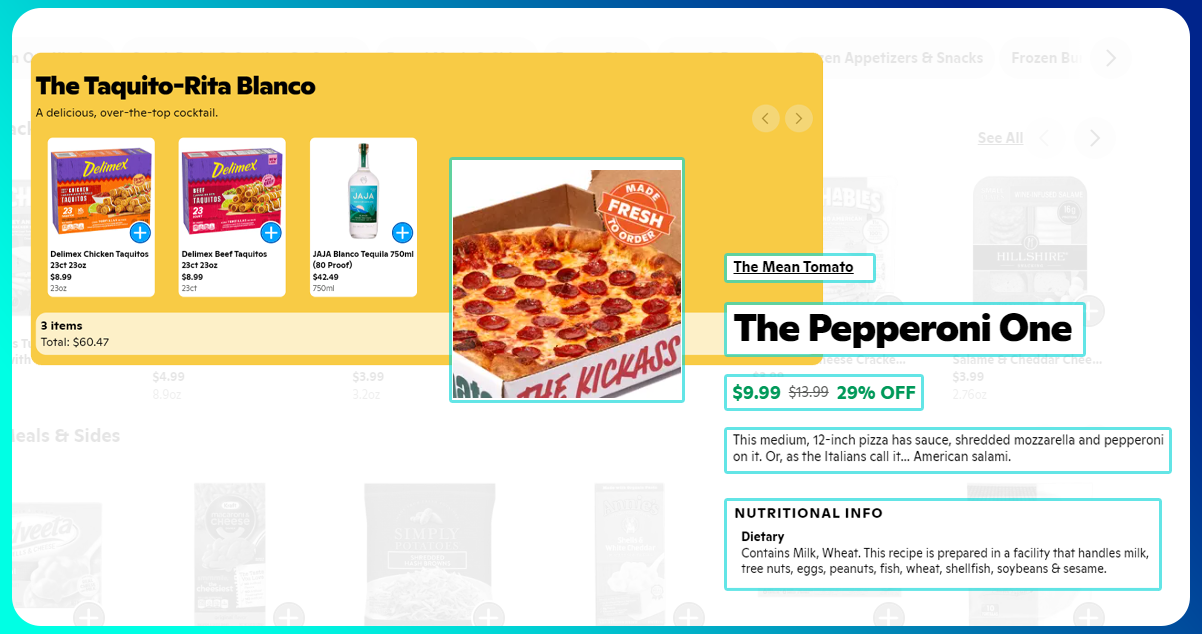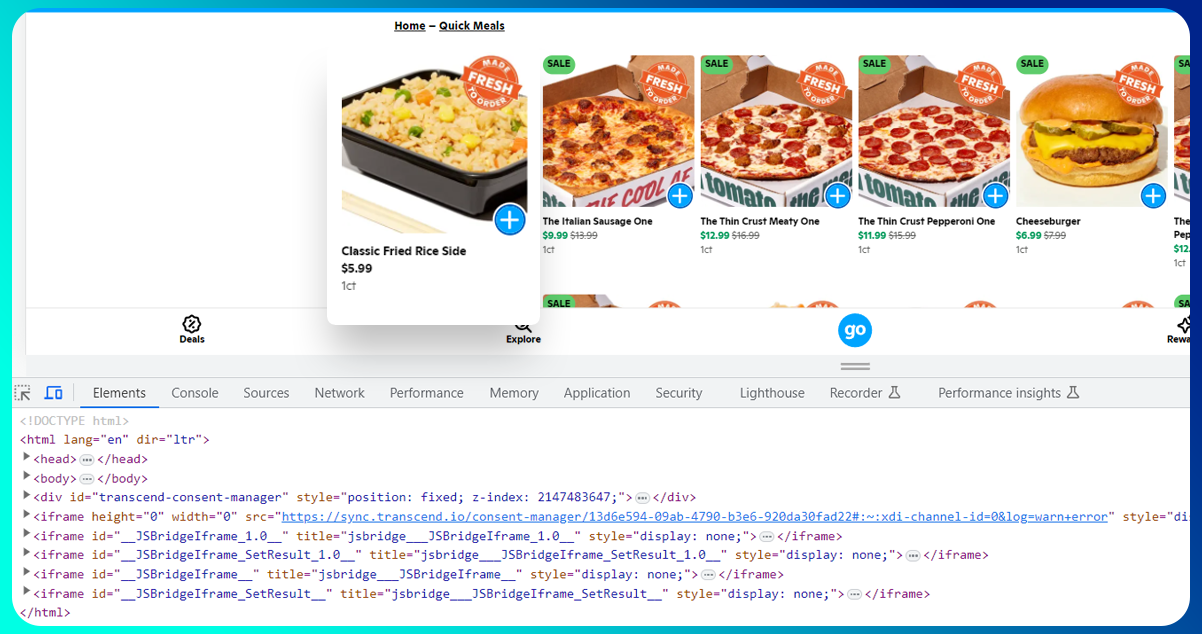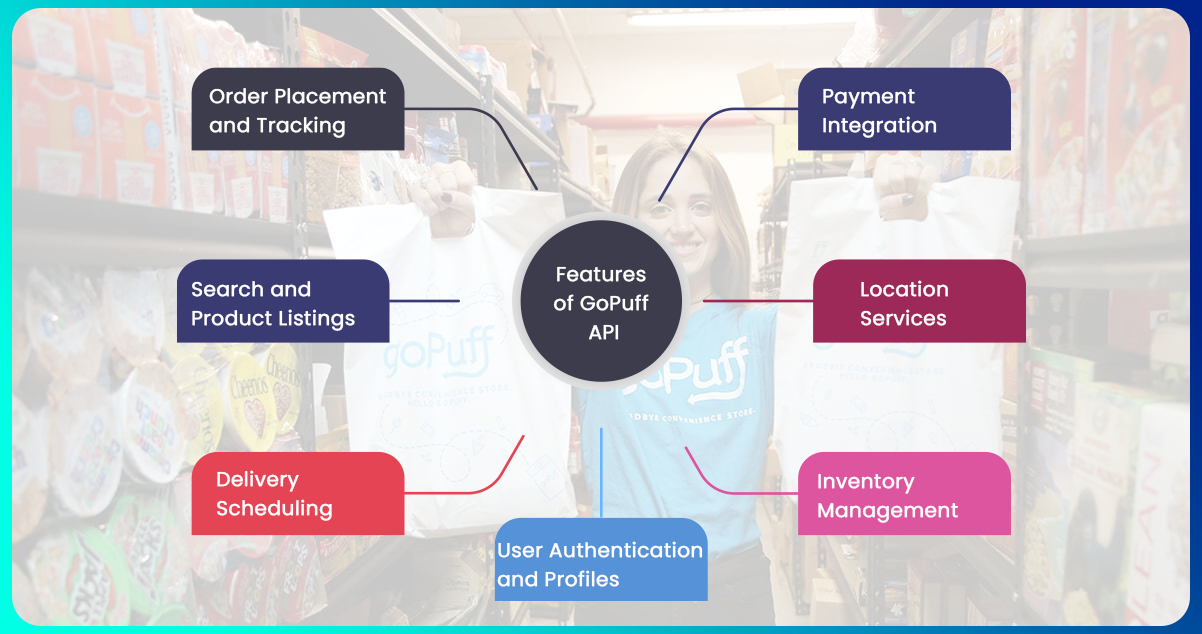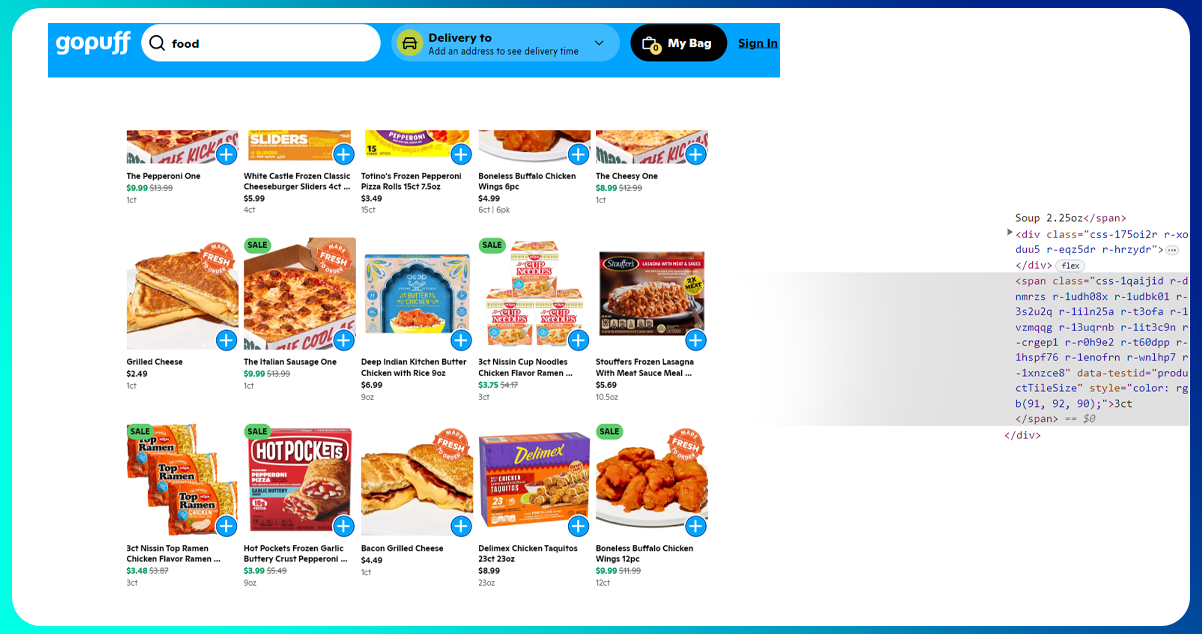Gopuff API scraping involves extracting data from Gopuff's application programming interface (API) to access information about products, orders, and more offered by the on-demand delivery service. By utilizing Python or other programming languages, developers can send HTTP requests to specific API endpoints, typically requiring authentication through API keys or tokens. The API responds with data in JSON format, which is parsed and processed to retrieve details such as product availability, pricing, order status, and user profiles. However, scraping should be performed responsibly, respecting Gopuff's rate limits and terms of service to ensure ethical and sustainable data retrieval practices. GoPuff API extraction is valuable for businesses and individuals looking to enhance their understanding of product availability and streamline their ordering processes.
List of Data Fields

- Restaurant's ID
- Restaurant's Name
- Address
- State
- City
- Country Code
- Postal Code
- Cost
- Aggregate Ratings
- Highlights
- Email Id
- Cuisines
- Latitude
- Longitude
- Opening Hours
- Menu
- Price Range
- Phone
- Review
- Website
- Votes
Significance of Gopuff API

The importance of a Gopuff API can be significant for various stakeholders, including customers, developers, and the company itself:
- Enhanced User Experience: APIs allow third-party developers to create applications or integrations to improve user experience. GoPuff food delivery data scraping allows customers to gain insights into ordering items through different platforms or devices, making it more convenient.
- Business Growth: APIs can open up new revenue streams and markets. Gopuff API allows businesses to integrate Gopuff's delivery service into their apps or websites to reach a wider audience and generate more sales.
- Increased Efficiency: Internally, APIs can streamline processes and increase operational efficiency. For Gopuff, an API could connect its order management system with its delivery logistics system, ensuring the orders' fulfillment quickly and accurately.
- Data Insights: Restaurant delivery data scraping services often provide access to valuable data. GoPuff could use data from its API to gain insights into customer behavior, market trends, and inventory management, allowing for better decision-making.
- Competitive Advantage: Offering an API to scrape food delivery data can set a company apart. It can attract partners and developers who want to leverage the company's services, creating a more robust ecosystem around the brand.
- Innovation: APIs encourage innovation by allowing third-party developers to experiment with new features and integrations. GoPuff could benefit from this by receiving innovative ideas from developers and integrating successful ones into their core offerings.
- Scalability: APIs are scalable, which means that as Food Delivery Scraping API Services grow, the API can handle increased traffic and demand without significantly affecting performance.
- Customer Loyalty: A well-executed API strategy can foster customer loyalty by offering more convenience and options for how customers interact with Gopuff's services.
Features of GoPuff API

- Order Placement and Tracking: Users can place orders for convenience items, snacks, and other products on Gopuff's platform via the API. They could also track the status and location of their orders in real time, receiving updates on when to expect their deliveries.
- Search and Product Listings: The Gopuff data scraping services could provide access to Gopuff's product catalog, allowing developers to integrate search functionality and display product listings within their applications or websites. This feature would make it easier for customers to browse and select items.
- Delivery Scheduling: An API could enable users to schedule deliveries for specific times or dates, accommodating their convenience. This feature is handy for customers who want to plan their orders ahead of time.
- User Authentication and Profiles: Developers could implement user authentication via the API, allowing customers to log in or create profiles within third-party apps. This feature would enhance personalization and simplify the ordering process.
- Payment Integration: Integration with various payment methods and gateways through the API would facilitate secure and efficient transactions. Users could store payment information for one-click ordering.
- Location Services: The API could provide location-based services, including geolocation, for users to find nearby Gopuff delivery options. It could also calculate delivery fees based on distance.
- Inventory Management: For Gopuff partners and businesses, an API might offer inventory management capabilities, allowing them to update product availability, pricing, and promotions in real time. This feature would ensure accurate product information for customers.
Steps to Scrape Real-Time Restaurant Data Using Gopuff API
Review Gopuff's API Documentation:
Begin by visiting Gopuff's official website or developer portal. Look for any available API documentation or guidelines. It's crucial to understand whether Gopuff allows scraping and to familiarize yourself with their terms of service regarding data usage.
Get API Access:
You'll likely need to sign up for developer access. This process typically involves registering for an API key or authentication credentials. This key will authenticate your requests to the API.
Authentication:
Once you have the API key or authentication credentials, you must use them to authenticate your requests. It is usually done by including the API key in the HTTP headers of your requests or as query parameters.
Understand API Endpoints:
Take the time to understand the API's endpoints thoroughly. In the context of Gopuff, you'd be interested in endpoints related to food delivery. It might include order placement, restaurant listings, menu items, and order tracking endpoints. Each endpoint serves a specific purpose, and you'll need to know how to use them effectively.
Make API Requests:
Use HTTP requests to interact with the API. For example, you might use a GET request to retrieve a list of nearby restaurants or a POST request to place an order. The specifics will depend on the endpoints you are working with.
Handle Pagination and Rate Limits:
If the API returns results in multiple pages (pagination), ensure that you implement pagination handling in your code to retrieve all the data you need. Additionally, be mindful of any rate limits imposed by the API. Exceeding these limits can result in restricted access, so adhering to them is essential.
Data Parsing:
After making API requests, you'll receive responses in a particular data format, such as JSON or XML. You'll need to parse these responses to extract the relevant data you want. It often involves using programming libraries or tools designed for data extraction.
Data Storage:
Store the scraped data in a structured format that suits your needs. Standard options include databases (SQL or NoSQL), CSV, and JSON files. Proper data storage ensures that you can analyze and use the data effectively.
Scheduled Scraping (Optional):
If you plan to scrape data from Gopuff's API regularly, consider setting up a schedule or automation for your scraping process. It ensures that you continuously have up-to-date information without manual intervention.
Respect Robots.txt and Terms of Service:
Always comply with Gopuff's terms of service and robots.txt file. These documents may specify rules and limitations on scraping activities. Avoid making excessive requests that could disrupt their service or violate their policies.
Testing and Error Handling:
Thoroughly test your scraping script to ensure it functions correctly. Implement robust error handling to gracefully manage issues like network failures, API changes, or unexpected responses.
Monitoring and Maintenance:
Continuously monitor your scraping process for any issues or changes in the API. GoPuff may update its API or change its terms of service, so you'll need to adapt your scraping code accordingly to maintain its effectiveness.
Why Scrape Gopuff Food Delivery Data?

Scraping Gopuff food delivery data can be valuable for several reasons, as it can provide consumers with enhanced convenience by enabling them to access Gopuff's offerings through different platforms or apps, making ordering their favorite snacks, beverages, and essential items easier. This accessibility can improve the overall customer experience. Secondly, businesses and entrepreneurs can use scraped data to analyze market trends, identify popular products, and explore potential collaborations or partnerships with Gopuff. Additionally, researchers and analysts may find the data helpful in studying consumer behavior and delivery service preferences, contributing to a better understanding of the evolving on-demand delivery market. However, it's crucial to conduct scraping activities responsibly and ethically, adhering to Gopuff's terms of service and data usage policies.
Conclusion: Scrape food delivery data using Gopuff API for numerous benefits. It enhances user experiences, opens new business opportunities, and facilitates data-driven insights. Developers can create innovative applications while customers enjoy increased convenience. However, it's imperative to approach scraping ethically, respecting Gopuff's terms of service and usage policies. By following best practices, businesses and individuals can leverage this data to stay competitive and provide valuable services in the ever-evolving food delivery industry.
For comprehensive details, don't hesitate to contact Food Data Scrape. We're your one-stop solution for Food Data Aggregator and Mobile Restaurant App Scraping service. Our advanced insights and analytics empower informed decision-making, elevating your business strategies. Contact us today for data-driven success!
























































































